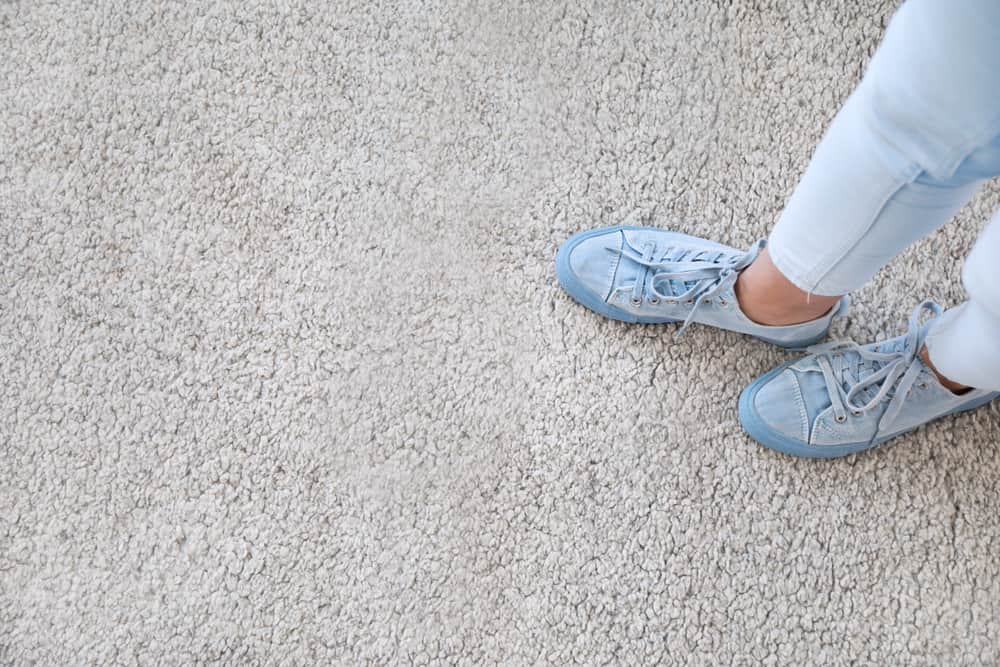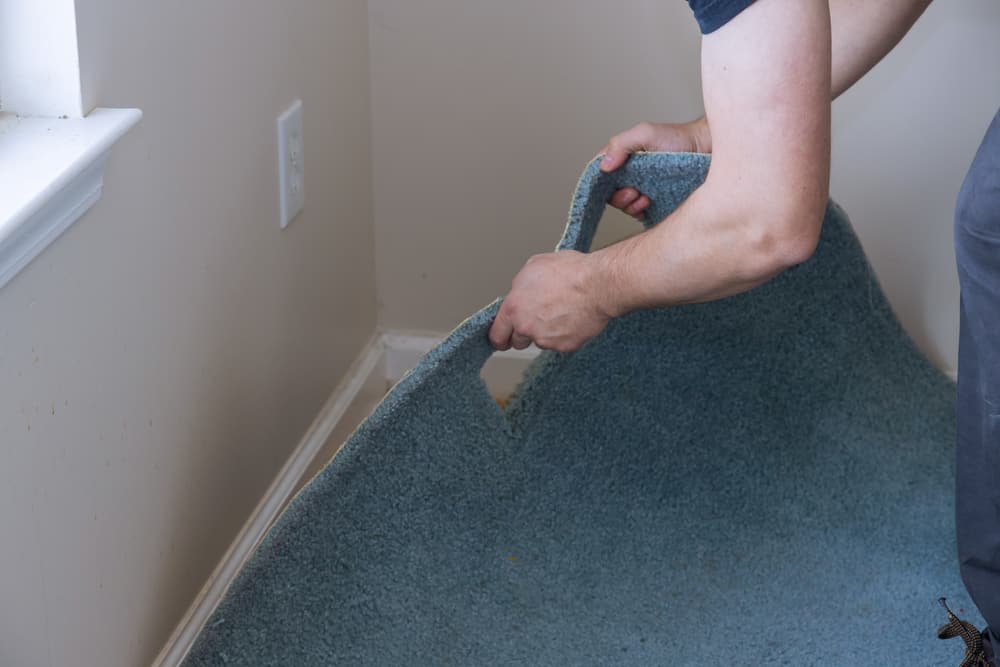If you’re planning on installing laminate or vinyl flooring in a room with carpet, one of the questions you’re probably asking yourself is, “Can you lay laminate or vinyl flooring over carpet?”
Yes, you can install your laminate or vinyl planks without necessarily having to remove an existing carpet. But this will depend on the type of carpet. If you have one of these thin, low pile carpets, you may be able to lay your floorboards directly over it.
Read on to find out when it’s possible to lay a floating floor over carpet and when underlayment is needed.
Table of Contents
What’s Your Current Flooring Situation?
To know whether you can install laminate or vinyl flooring over your carpet or not, you need to first understand the current situation of your floor and whether it is actually possible to remove the carpet or not.
For most people, the idea to lay their laminate or vinyl over an existing carpet is geared by the fact that they are not allowed to remove the carpet. This is particularly true for rented homes and apartments. Most landlords will not allow tenants to do anything that will change the rented space permanently.
There are some people, however, who are just not physically able to remove the carpet or who are just not willing to pay someone to do the extra job for them before laying the new flooring.
Also, keep in mind that removing and disposing of an old carpet is often time-consuming. As such, most people will just have their new flooring installed over the carpet. You see, as long as the surface of your carpet is level, installing your planks without first stripping the carpet off the floor is possible.
However, depending on the type of carpet that you have, there are some things you need to think about to know for sure whether keeping the carpet is an option or not, as discussed below.
Consider the Type of Carpet You Have
Whether you fall under one of the above categories of people or you just want to install a temporary floating floor on top of an existing carpet, one of the things you should consider before laying your laminate or vinyl flooring is the type of carpet installed in the room.
If you have a sturdy, low pile carpet, then it is possible to install the new flooring over it. So long as it is level and not damaged, your laminate or vinyl planks will sit properly on top.
Do not add any underlayment, as the carpet is already providing the padding you are looking for; plus that extra material can shorten the height of the room.
Also, make sure that the carpet fibers are no more than a quarter inch long. If they are too long, the carpet will not provide the stability needed to hold the new flooring in place.
That plush carpet in your bedroom or living room, for instance, should never have laminate or vinyl flooring laid over it. Because such carpets are usually very soft, they will not offer the support your flooring needs to keep the tongue and groove system locked properly.
Removing the Carpet Has Its Benefits
While it is possible to install laminate or vinyl flooring over carpet, experts usually recommend completely removing the carpet. Getting rid of the carpet not only allows you to start with a clean slate but also has the following benefits:
It Reduces the Number of Allergens
It is normal for dust, dirt, debris, and other everyday allergens to attach themselves to the carpet. Even though these will be removed when you vacuum the carpet, if the cleaning is not done properly and a new floor is set over the carpet, these allergens will be trapped underneath the floor and you won’t be able to get them out of your home.
Removing the carpet also reduces the risk of trapped moisture. If you cleaned your carpet and for some reason it did not dry completely before the new flooring was laid on it, the moisture trapped under your flooring will ultimately become a breeding ground for mold.
This mold will spread underneath your laminate or vinyl flooring, which will not only reduce the lifespan of your flooring but also put you and your loved ones at risk of developing respiratory allergies and diseases.
Your Floor Becomes More Even
Any part of your flooring subjected to high traffic will tend to wear and tear faster. If you install your laminate or vinyl flooring over carpet in an area where it is walked on quite often, the carpet fiber will shrink over time, causing your new flooring to become uneven.
And if your flooring is floating over a carpet whose pile is starting to shrink, the flooring will begin to strain, causing it to snap or warp at the joints.
What to Do If You Remove the Carpet
If you decide to get rid of the carpet before your installation, it is recommended that you get rid of the underlayment too. The underlayment used for carpet is usually too soft and may not be able to hold the new flooring well.
You should also ensure that the subfloor is smooth, clean, and in good condition. Sand any bumps so your planks will have a smooth surface to sit on.
Keep in mind that you may need to set up a new underlayment for the type of floor you are installing. However, this will depend on the type of subfloor and whether the flooring comes with pre-attached padding or not.
If you are installing padded flooring over a wood subfloor, you will not need any underlayment. You would require underlayment, though, if you are installing the flooring on a concrete subfloor to provide extra insulation and prevent water vapor from reaching your new flooring.
For flooring without pre-attached underlayment, you will require an underlayment, whether you are doing your installation over a cement subfloor or a wooden one.
For best results, keep your underlayment as thin as possible. A thick underlayment may raise the floor, reducing the height of the room and causing you to have to trim door frames so the door can open and close properly.
How to Lay Laminate or Vinyl Flooring Over Carpet
If the existing carpet must stay and you are ready to lay laminate or vinyl flooring over it, use the following quick guidelines to do it right.
- Remove furniture, appliances, and other obstacles from the room. Also, remove the baseboards so they don’t get in the way.
- Vacuum the carpet to get rid of any dirt and debris that may be attached to it. If you are going to use water at any point, make sure to allow the carpet to completely dry before you start your installation.
- Now, lay your laminate or vinyl flooring over the carpet as instructed by the manufacturer. Make sure the planks interlock tightly at the seams. You can use a tapping block or rubber mallet to lightly hit the planks so they can nicely lock together.
- Once done, put the baseboards back in place and bring the furniture back into the room. Try to open or close the door to see if it functions as desired. If it gets stuck, you may want to trim the bottom frame.
How to Get the Most Out of Your Installation
As stated earlier, you will have the best outcome if you are working with a low-pile carpet. For carpets with plush and thick fibers, you will need to lay plywood over them before installing the flooring. However, the plywood must be thin enough to avoid raising the floor too high.
While at it, avoid using soft underlayments like foam or cork sheets; these will not be sturdy and stable enough to hold the planks nicely in place.
Placing your flooring directly over a high pile carpet will result in shifting floorboards, and this can cause the seams to open very easily especially in high traffic areas.
Think about the thickness of your flooring too. If you have thick laminate or vinyl planks and a high-pile carpet, then removing the carpet would be a more viable option than getting an underlayment for the flooring. By getting rid of the carpet, you will be able to install your thicker planks without worrying about shortening the height of the room.
The Takeaway
While laying laminate or vinyl flooring over carpet can be done, it is only recommended for floors with low-pile carpets. If you must install your flooring on a high-pile carpet, make sure to use an underlayment like plywood, and importantly, go for the thinnest sheets possible.
It is also important that you clean your carpet thoroughly and let it dry completely before the installation. This will prevent trapping dirt and moisture underneath the planks and putting your new flooring at risk of molding.


I’m using Robert’s Microban pad sold at HD for pad on concrete its great with an R value.